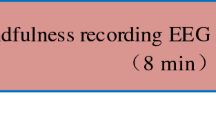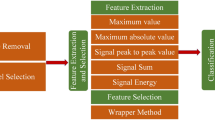Abstract
Miner’s wearable robot is an important mobile terminal of the monitoring network for the coal mine production safety. However, it is difficult to find the study on the miner’s emotion change using brain-computer interface (BCI) for miner’s wearable robot, especially for the smart helmet. This paper explores the anxiety change rule and the detection method using BCI of miner’s smart helmet. There are three contributions in this paper. Firstly, an emotional state evoked paradigm is designed to find the brain area where the emotion feature is most obvious. Then, the accurate electrode position is determined for the electroencephalograph (EEG) collection of the negative emotion on the basis of the international 10–20 systems. Secondly, a fusion algorithm of the anxiety level is proposed to evaluate the miner’s mental state by using the θ, α, and β rhythms of EEG. Thirdly, the miner’s smart helmet system is built to collect the human state which includes the mental parameters of the anxiety level, the fatigue level, the concentration level, and the environmental parameter in coal mine. Experiments demonstrate that the position Fp2 is the best electrode position for obtaining the anxiety level parameter. The most obvious EEG changes appear within the first 2 s after the stimulator works. The amplitudes of the θ rhythm increase most obviously in the negative emotion. In addition, the fusion algorithm of the anxiety level parameter has a good following function to the negative emotion change. This method can reflect quantitatively the anxiety level of a human. So it is avoided for the miner to operate improperly, and then the operation safety can be improved.











Similar content being viewed by others
References
Huimin L, Yujie L, Min C, Hyoungseop K, Seiichi S (2017) Brain intelligence: go beyond artificial intelligence. Mobile Networks and Application (arXiv:1706.01040):1–15
Langp J, Bradleym M, Cuthbertb H (1997) International affective picture system(IAPS): technical manual and affective ratings. The Center for Research in Psychophysiology, University of Florida, Gainesville
Shin D, Shin D, Shin D (2017) Development of emotion recognition interface using complex EEG/ECG bio-signal for interactive contents. Multimesia Tools and Applications 76(9):11449–11470
Raja MM, Hyo JL (2016) A novel feature extraction method based on late positive potential for emotion recognition in human brain signal patterns. Comput Electr Eng 53:444–457
Hong-mei Z (2011) Feature extraction and analysis of visual evoked EEG in emotion images. Master’s Degree Thesis, Tianjin University, pp 22–34
Dan N, Xiaowei W, Ruonan D et al (2012) Survey of emotion recognition based on EEG. Chin J Biomed Eng 31(4):595–606
Khalili Z, Moradi MH (2015) Emotion recognition system using brain and peripheral signals: using correlation dimension to improve the results of EEG. International Joint Conference on Neural Networks. IEEE Press 1920-1924
Jyotish K, Jyoti K (2016) Affective modelling of users in HCI using EEG. Procedia Computer Science 84:107–114
Stefano V, Tanvir I, Peter J, Andrzej C (2014) Individual classification of emotions using EEG. J Biomed Sci Eng 7(8):604–620
Zouridakis G, Patidar U, Padhye NS et al (2009) Spectral power of brain activity associated with emotion -a pilot MEG study. IFMBE Proc 28:354–357
Murugappan M, Rizon M, Nagarajan R et al (2007) Time-frequency analysis of EEG signals for human emotion detection. 4th Kuala Lumpur International Conference on Biomedical Engineering 2008:262–265
Zhifei Z, Duoqian M, Hongyun Z (2015) Multi label emotion classification based on decision rough set. Pattern Recognit Artif Intell 28(8):680–685
Peng HQ (2013) The wavelet packet transformation and nonlinear analysis of EEG signals are used to determine the state of mental fatigue. Vibration and Shock 32(2):182–188
Vadim Z, Han Y, Masaya M, Raquel P, Kymberly DY, Matthew TE, Jerzy B (2016) Correlation between amygdala BOLD activity and frontal EEG asymmetry during real-time fMRI neurofeedback training in patients with depression. Neuro Image Clinical 11:224–238
Siao ZB, Khairunizam W, Murugappan M, Norlinah MI, Yuvaraj R, Khairiyah M (2017) Implementation of wavelet packet transform and non linear analysis for emotion classification in stroke patient using brain signals. Biomed Signal Process Control 36:102–112
Mei W, Wen-Yuan C, Xiangdan L (2016) Hand gesture recognition using valley circle feature and Hu’s moments technique for robot movement control. Measurement 94(2016):734–744
Andrey VB, Gennady GK, Alexander NS (2017) Depression and implicit emotion processing: an EEG study. Neurophysiologie Clinique/Clinical Neurophysiology 47(3):225–230
Mei W, Lin G, Wen-Yuan C (2016) Blink detection using Adaboost and contour circle for fatigue recognition. Comput Electr Eng 58(2017):502–512
Seiichi S, Huimin L (2014) Underwater image dehazing using joint trilateral filter. Comput Electr Eng 40(1):41–50
Huimin L, Lifeng Z, Seiichi S (2012) Maximum local energy: an effective approach for image fusion in beyond wavelet transform domain. Computers & Mathematics with Applications 64(5):996–1003
Acknowledgements
This research was sponsored by the Natural Science Foundation of China (51405381), Key Scientific and Technological Project of Shaanxi Province (2016GY-040), the Science Foundation of Xi’an University of Science and Technology (104-6319900001), Leading Initiative for Excellent Young Researcher (LEADER) of Ministry of Education, Culture, Sports, Science and Technology-Japan (16809746), Grant in Aid for Scientific Research of JSPS (17 K14694), Research Fund of State Key Laboratory of Marine Geology in Tongji University (MGK1608), Research Fund of State Key Laboratory of Ocean Engineering in Shanghai Jiaotong University (1510), Research Fund of The Telecommunications Advancement Foundation, Fundamental Research Developing Association for Shipbuilding and Offshore and Strengthening Research Project of Kyushu Institute of Technology.
Author information
Authors and Affiliations
Corresponding authors
Rights and permissions
About this article
Cite this article
Wang, M., Zhang, S., Lv, Y. et al. Anxiety Level Detection Using BCI of Miner’s Smart Helmet. Mobile Netw Appl 23, 336–343 (2018). https://doi.org/10.1007/s11036-017-0935-5
Published:
Issue Date:
DOI: https://doi.org/10.1007/s11036-017-0935-5




